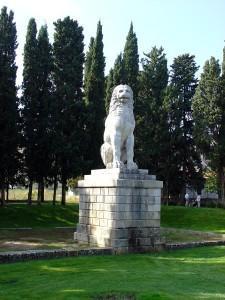 |
|
The Lion of Chaironeia
|
The Lion of Chaironeia
Chaironeia lies on the main route from Phokis (Fokis or Fokida) to north Greece, and to Viotia (Boeotia) and Attica. One of the most important events in its history took place on the small plain between the foothills of Mt Thourion and the Boetian river Kephisos. This was the battle fought in 338 B.C. which established the supremacy of Phillip II in the south of Greece.
The Athenians had taken up a position to the east of Chaironeia, near the stream of Aimon and the foot of Mt Thourion, opposite Philip, while the Thebans were arrayed against 18-year-old Alexander in the plain near Kephisos. In the battle that followed, the members of the Theban Sacred Band were killed fighting heroically. Two 'polyandria' (common tombs) were erected on the positions occupied by the rival forces. The site where the Macedonians were buried was found and excavated by the Ephor of Antiquities Sotiriades in 1902-1903, three kilometers (1.86 miles) to the east of Chaironeia. It is a tumulus 7 meters (21 feet) high. At the point where the fallen members of the Theban Sacred Band were buried, with the permission of Philip, a colossal lion was erected facing the Macedonian tumulus. The lion was considered a symbol of heroism and Philip, a soldier himself, could not refuse Thebans their request.
In ancient times the lion was assembled from five pieces of marble. At some point over the centuries, the statue collapsed and broke to pieces, possibly as a result of subsidence of the ground or of an earthquake, or because of the poor quality of the stone of which the base was made. Lord Byron found it in pieces and partly buried when he visited it on his way from Ioannina to Athens in 1809. The Englishman Crawford discovered the head and a few more pieces during an improvised excavation in 1818, but covered them again. The Turkish Sultan wanted the Lion for Constantinople and Ali Pasha for Ioannina, but they gave up their claims because of the difficulty of transporting it; they should have asked Lord Elgin for his expert advice!
The site was excavated by the Archaeological Society in 1879, when 254 skeletons were found buried in seven rows within an enclosure. The restoration of the monument was begun in 1902 by the sculptors Phytalis and Sochos, with funds provided by the Archaeological Society. A pedestal 3 meters (9 feet) high was constructed and the pieces were reassembled, missing parts being restored with stone from Xiria near Livadia. The total height of the monument reached 5.5m (16.5ft), and was positioned against a backdrop of cypress trees by the roadside, next to the local museum. In 1998-2000 the monument was conserved (the surface was cleaned and the mortar replaced) by the IX Ephorate of Prehistoric and Classical Antiquities in collaboration with the Center of Stone of the Hellenic Ministry of Culture.
The Museum of Chaironeia
An archaeological collection existed in Chaironeia since 1870. Because of the increasing bulk of the archaeological finds a new Museum was necessary, which was built by the Archaeological Society and inaugurated in 1907. Because of earthquake damages the building was under restoration and remained temporarily closed during 2005 and first half of 2006.
The Museum comprises:
A Neolithic collection A Collection from the cemetery of Abai (vases, figurines)
An Epigraphic collection.
The most important exhibits are:
A clay model of a house, from the neolithic settlement at Magoula Balomenou, Chaironeia.
A clay female figurine painted with geometric patterns from the neolithic settlement at Magoula Balomenou, Chaironeia.
| 


